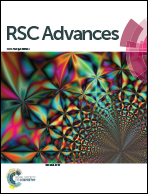MoS2 nanosheet production by the direct exfoliation of molybdenite minerals from several type-localities†
Abstract
Samples of the mineral molybdenite from three classic molybdenum mining localities were examined as a potential source of molybdenum disulfide (MoS2) nanosheets. In all cases, ultrasonication-promoted exfoliation of these samples in N-methylpyrrolidone (NMP) was found to produce MoS2 as dispersed nanosheets with lateral sizes in the range of 200–600 nm and thicknesses between 1 and 10 atomic trilayers. The MoS2 nanosheets obtained were found to be highly crystalline and largely defect-free, but tend to contain small amounts of aggregates on their surfaces. The exfoliated MoS2 dispersions were characterised by UV-Vis spectroscopy, Raman spectroscopy, scanning electron microscopy (SEM), (scanning) transmission electron microscopy ((S)TEM) and energy dispersive X-ray (EDX) spectroscopy. This work raises the possibility that mined, unrefined minerals could be a source of low-dimensional MoS2.


 Please wait while we load your content...
Please wait while we load your content...